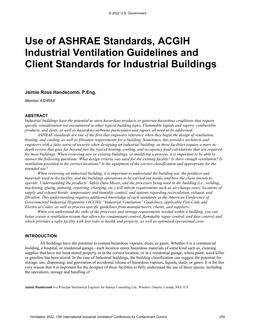Click here to purchase
Industrial buildings have the potential to store hazardous products or generate hazardous conditions that require specific consideration not encountered in other typical building types. Flammable liquids and vapors, combustible products, and dusts, as well as hazardous airborne particulates and vapors all need to be addressed. ASHRAE standards are one of the first that engineers reference when they begin the design of ventilation, heating, and cooling, as well as filtration requirements for a building. Sometimes, this provides architects and engineers with a false sense of security when designing an industrial building, as these facilities require a more in-depth review that goes far beyond just the typical heating, cooling, and occupancy load calculations that are required for most buildings. When reviewing new or existing buildings, or modifying a process, it is important to be able to answer the following questions: What design criteria was used for the existing facility? Is there enough ventilation? Is ventilation provided in the correct locations? Is the equipment of the correct classification and appropriate for the intended use? When reviewing an industrial building, it is important to understand the building use, the products and materials used in the facility, and the buildings operations to be carried out inside, and how the client intends to operate. Understanding the products’ Safety Data Sheets, and the processes being used in the building (i.e., welding, machining, gluing, painting, repairing, charging, etc.) will inform requirements such as air change rates; locations of supply and exhaust hoods; temperature and humidity control; and options regarding recirculation, exhaust, and filtration. This understanding requires additional knowledge of such standards as the American Conference of Governmental Industrial Hygienists (ACGIH) “Industrial Ventilation” Guidelines, applicable Fire Code and Electrical Codes, as well as process specific guidelines from manufacturers, clients, and suppliers. When you understand the risks of the processes and storage requirements needed within a building, you can better create a ventilation system that allows for contaminant control, flammable vapor control, and dust control, and which provides a safer facility with less risks to health and property, as well as optimised operational costs.
Product Details
- Published:
- 2022
- Number of Pages:
- 8
- Units of Measure:
- Dual
- File Size:
- 1 file , 880 KB
- Product Code(s):
- D-IIVC2022-C038
- Note:
- This product is unavailable in Russia, Belarus
